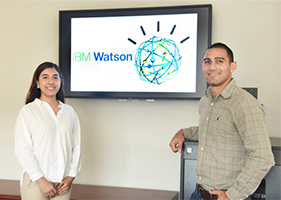 A senior design capstone team in the Department of Industrial and Systems Engineering at Texas A&M University evaluated IBM Watson for use as the “brain-system” in an on-campus autonomous paratransit shuttle. This was the first time IBM partnered with a major university to explore the use of Watson’s services in alternative transportation mobility solutions.
A senior design capstone team in the Department of Industrial and Systems Engineering at Texas A&M University evaluated IBM Watson for use as the “brain-system” in an on-campus autonomous paratransit shuttle. This was the first time IBM partnered with a major university to explore the use of Watson’s services in alternative transportation mobility solutions.
Undergraduate students Alejandra Hernandez and Alejandro Cuellar were given the task to analyze what IBM Watson, an advance artificial intelligence (AI) technology, is capable of. They researched the transportation needs of the mobility challenged students at Texas A&M and how IBM Watson could fulfill these needs as the interface between the transportation vehicle, an autonomous shuttle and the mobility-challenged passenger.
“Imagine you broke your leg and you had to go from West Campus to the Engineering Technologies Building,” said Hernandez. “Our research studied the feasibility of having an on-demand driverless vehicle that could pick you up, and you could have a conversation with, as if it were a human.”
Dr. Tom Ferris, associate professor in the department, was the team’s faculty advisor.
“I am very excited to see our students applying their industrial engineering knowledge to the research and design of new technologies such as this,” said Ferris. “Alejandra and Alejandro especially made me proud in the way they conducted analyses of potential user groups, a skill that we teach in our courses related to human-systems interaction, to determine key human factors that should be considered in the development of this vehicle.”
Hernandez enjoyed working with IBM Watson and through the partnership, was reminded that technology and humankind are meant to work together.
“We can choose to focus on the negative sides of it, or we can focus on the beautiful and useful way to extend the human capabilities to those who are in need,” said Hernandez.
Cuellar enjoyed working with IBM Watson because use of artificial intelligence software was something new, and he believes there will be an increase in the use of it in the coming years.
“I feel honored to have the opportunity to represent Texas A&M in a project that positively impacts the lives of others,” said Cuellar.
Their paper on the topic was accepted for presentation at the Transportation Research Board’s 2018 annual meeting in Washington, D.C. in January. The meeting focused on transportation modes, with more than 5,000 presentations in nearly 800 sessions and workshops, addressing topics of interest to policymakers, administrators, practitioners, researchers, and representatives of government, industry and academic institutions.
Bob Brydia, senior research scientist for the Texas A&M Transportation Institute, leads the Campus Transportation Technology Initiative, which worked with IBM and the College of Engineering to find ways to improve campus transportation.